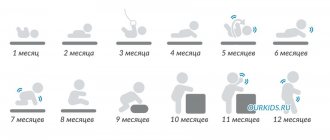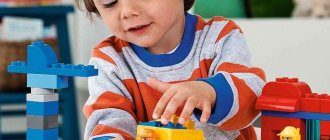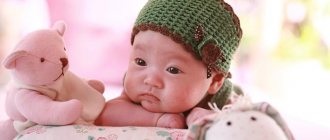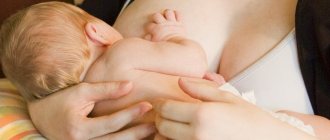What can a 1 month old baby do?
Physical development in 1 month of life is manifested by reflex characteristics that help the newborn adapt to the outside world. Some reflexes are innate and can disappear or transform, reaching a new level of consciousness.
In the first month of life, a newborn has the following reflex abilities:
- Grasping. They belong to primitive reflexes: the child tries to grab and hold any objects touching his palm. The reflex appears already in the womb at 16 weeks of pregnancy and persists until five or six months after birth.
- Search engines or Kussmaul reflex. The child turns his head when his cheek is touched, opens his mouth when light pressure is applied to the middle of the lower lip. This reflex is considered as an instinctive search for food.
- Stop reflex (plantar). When you touch or run a finger (pencil) along the baby’s foot, his toes diverge to the sides, and abduction of the foot is also noted.
- Moro reflex. An important indicator of your baby's normal and developing nervous system. This is a reflexive reaction of babies to fear, which is characterized by stretching their arms out to the sides and then bringing them closer together. You can check the reaction in the following way: suddenly straighten the legs of a baby lying on his back or lift the baby’s straightened legs up along with the pelvis. Sharply clap your hands next to the lying child.
- Babkin reflex. Manifested by opening the mouth and bending the arms in response to stimulation of the palms. This is a normal reaction in the first 10 weeks of life and it manifests itself quite clearly. If the reflex is sluggish or absent, a possible problem with the central nervous system should be considered.
- Swimming reflex. If the baby is placed on his stomach, he will begin to make movements that imitate swimming.
- Reflex walking. If the newborn is slightly tilted forward, he should be able to make stepping movements (automatic gait).
Newborn skills in the first month of life
During the first month and the beginning of the second, the newborn demonstrates the ability to concentrate attention on certain objects. In the first month of life, the nervous system actively develops, and the process of synthesizing and differentiating external signals begins.
Physical activity
At 1 month, the child’s motor activity does not have clear coordination, but is already quite well manifested. The muscles are in physiological hypertonicity - fingers in fists, legs bent at the knees. It is important for parents to learn to recognize their baby's body language. Clinical studies in pediatrics have proven that curling of the toes often indicates pain. With the development of colic and bloating, the newborn often actively waves its legs, creating knocking movements.
Visual system
The baby's eyes, as an organ of the visual system, are already fully formed, but vision is not clear enough. The infant has difficulty focusing on objects and can barely see images with their eyes. However, bright, light objects encourage the child to look closely at them. By the end of the fourth week of life, reflexive eye movements appear, and the ability to distinguish the shape and size of objects gradually develops.
Auditory sensory system
In the first month, the newborn develops conditioned reflex reactions to sounds and is already able to recognize the mother’s voice. You can see how a child smiles during a conversation or stops crying when he hears a familiar voice. The external auditory canal in infants, unlike in adults, is located vertically and rather narrow, consists of cartilaginous tissue, which gradually ossifies.
For the first month of life, the child has the following skills
:
- tries to focus his gaze on a person/object;
- notices bright objects, reacts to light;
- if you put a toy in your palm, the baby will quickly grab it and instantly let go;
- knows how to distinguish the mother by the timbre of her voice and smell;
- expresses discomfort, hunger or thirst through crying;
- responds to warm, sensitive, physical contact and care.
Is it possible to skip doctor visits?
During the first scheduled examination of a child at 1 month, consultation with specialized specialists is needed to assess the child’s condition and development. Additional diagnostics may also be needed. All this is necessary in order to make sure that the baby is developing according to his age category, that he does not have any developmental abnormalities, diseases or pathological processes. Therefore, it is recommended not to ignore the child’s first examination at 1 month.
There are objective reasons why a mother may not come with her child for an examination:
- being in hospital;
- acute infectious disease;
- It is temporarily impossible to get to the doctor.
When undergoing a routine medical examination, parents can ask any questions and inquire about the results of the examinations. The doctor tells you what processes are happening in the baby’s body and gives advice on caring for him. The first month is the period of adaptation of the newborn’s body to external circumstances.
How much should a baby weigh at 1 month - normal weight for boys and girls
The weight of the child is calculated based on the period at which he was born. In case of premature birth (32 weeks), body weight does not exceed 2100 g. Newborns weighing more than 4000 g are considered large babies. Often this weight indicates that the mother has a carbohydrate disorder.
When a child is born at normal terms, the weight for boys is from 3.5 to 5.5 kg, for girls - 3.1-5.2 kg. With normal physical development, the baby gains 100–200 g per week. On average, in 1 month of life there is a weight gain of 600 g, and then about 800 g every month.
Mental development of a child at 1 month
- Starting from the third week, the newborn begins to understand how to achieve his goal. If the mother's attention is needed, loud, prolonged screams begin. At 1 month, the child’s need for social communication increases, the baby is already focused on his parents. Loves to look at new faces and begins to smile back. He is surprised and amazed at new sounds.
- At this period, psychological development depends on the physical state. Many pediatricians recommend daily light massage in the form of stroking. A healthy baby prefers the hands of a mother or father: this allows for closer contact with parents and has a positive effect on the psycho-emotional background of the newborn.[1]
- So far, a child has only two options for expressing emotions - smiling and crying. The ability to respond with a smile in return develops by the end of the fourth week. A healthy atmosphere in the home contributes to the proper development of a child; conflict situations should be avoided and relations should not be sorted out in a raised voice in front of the baby.
- Research has shown that positive contact with parents is more beneficial for the emotional and psychological development of the child. Experiments have been conducted with infants under four months of age using both positive touch (stroking or hugging) and negative touch (pushing, pinching or tickling).
- Babies who received positive touch cried less often and smiled much more often than babies who received negative touch. It was found that newborns with negative communication experiences in infancy were more likely to experience emotional and behavioral problems in later life.
Psycho-emotional changes
A child of 1 year and 3 months wants to demonstrate his independence. He becomes stubborn, capricious, may not obey and contradict everything. Especially if you speak to him in an orderly tone.
However, at the same time, the baby is constantly looking for support from adults, trying to imitate them in everything (coughs like grandpa, “reads a book” like dad, “talks on the phone” like mom). He may be upset if something did not work out, or rejoice at success. His attention can now easily be switched to another object or action.
What else is filled with the world of a child’s experiences?
- Favorite games are with a ball. They evoke a storm of vivid emotions.
- Having “gutted” the cabinets and bedside tables, the child can look at each item with enthusiasm for a long time.
- He likes to put things in a box and take them back out.
- He loves to walk very much - because on a walk new discoveries and emotions await him.
- Expresses his feelings for loved ones and toys (with hugs, kisses).
- Understands which loved one is being talked about if you say a specific name.
- Performs simple tasks (give, fetch, take, throw, pick up).
- With interest he builds a tower out of cubes.
- In addition to toys, he is interested in household appliances and their structure (tries to disassemble and study).
- The role of toys can already be played by household items (shoes, dishes, mother’s cosmetics, boxes, jars, clothes).
- During play, he “communicates” with toys and shows vivid emotions.
- Trying to draw.
- Begins to imitate his peers (may cry if a baby is crying nearby, laugh if he laughs).
Child care in the first month
- It is recommended to bathe your newborn daily, and use baby detergents no more than twice a week. Plain water is best for baby's skin in the first month.
- After the bath, the child's skin should be thoroughly dried with a clean towel, taking care not to miss any wrinkles. After bathing, it is allowed to apply creams or oils intended for newborns. It is best not to bathe your baby immediately after feeding when he is hungry or tired.
- An important point in care is changing the diaper. Immediately after emptying or urinating, you need to change the diaper, this will avoid the development of bacterial infection and inflammatory processes. Often, the process of defecation in children occurs immediately after feeding. Some babies don't respond to a full diaper, so it's worth checking every few hours. Every time before changing a clean diaper, hygiene of the newborn’s genitals is carried out. After the skin is dried, a cream or powder is applied to prevent irritation.
- For first-time parents, purchasing the right diaper size can be challenging as different brands have different sizing standards. Baby diaper sizes are based on the baby's weight, which should be taken into account when choosing a product.
- Caring for a child involves cutting nails. The procedure should be done regularly as the nail plate grows. For this purpose, special scissors designed for young children are used. Such a tool has increased safety and minimizes the possibility of injury.
- If it is necessary to treat the umbilical wound, use a Chlorophyllipt solution at a concentration of 1%, but more often they resort to using ordinary brilliant green. The product has an antibacterial effect, accelerates the healing process without side effects.
- When caring for a child, it is important to adhere to the correct temperature regime; overheating and hypothermia must be avoided.
- A daily walk in the fresh air is absolutely necessary, at least 30 minutes in the autumn-winter period and an hour or two in the summer.
- The psychological and physical development of a child largely depends on the parents. Feeding and putting to bed is not enough. Communicate with your baby, talk, turn on music. This promotes the development of the hearing system and has a positive effect on the psycho-emotional background.
It is important to think through all the little things that relate to caring for a newborn. If you have the slightest doubt, you should contact an obstetrician-gynecologist or consult a pediatrician. Competent care is the key to a happy and healthy child[2].
Find out about baby development at two months using the link.
1. “The first days of life. A textbook on newborn care." Rylova Natalya Yurievna. Here: “Pediatrics: a complete guide for parents.” Larisa Anikeeva
2. “The beginning of life. Your child from birth to one year.” Evgeny Olegovich Komarovsky. Here: “Care for a newborn. A complete encyclopedia for parents." Bogomolov B. N.
Features of physiology at one and a half and two months
During the first months, the baby grows very rapidly. His organs and systems adapt to the environment, and the baby himself instinctively reaches out to his mother. For up to a year, visits to the pediatrician occur every month. At the appointment, the child is measured, weighed, the functioning of the heart and lungs, the presence of innate reflexes, muscle tone are checked, and the skin is examined. Indicators of anthropometric measurements may depend on the individual development of the child and on indicators at birth. However, their difference from the norm is not a sign of pathology. After examining the child, the pediatrician makes a conclusion about his physical development.
The infancy period is a time of intensive growth and development of the child.
Average anthropometric indicators in newborns and at two months: height and weight norms - table
| Age | Weight, kg | Height, kg | Head circumference, cm | Chest circumference, cm |
| 1 month | 3700–4100 | 54–55 | 36–37 | 35–36 |
| 2 month | 4500–4900 | 55–59 | 38–39 | 37–38 |
From one to two months, the child gains about 800 g of body weight, height increases by about 3 cm, and head and chest circumference by 1–2 cm.
Up to four months of age, increased muscle tone can be detected in children. In most cases this is normal. The baby was forced to remain in the fetal position throughout the pregnancy. After birth, his body adapts to new conditions gradually, and hypertonicity also slowly disappears. But sometimes increased muscle tone can be an unpleasant symptom of some disease. For example, this is how cerebral palsy manifests itself, congenital pathologies of the brain, prolonged asphyxia (lack of oxygen) during childbirth, etc. In diseases, this symptom is not the only one, therefore, during the examination and diagnosis, the doctor takes into account the general development of the baby, the presence of reflexes, data Ultrasound and computed tomography.
Let's start with the fact that in children under the age of one year, muscle tone is physiologically (i.e. in the most natural way) higher than in older children. “What is the danger of increased muscle tone in children under one year old?” All this is very similar to a briefcase standing alone in a subway car. It could be a bomb, or maybe some jaded engineer forgot. Having discovered a briefcase, you should call specialists - let them sort it out: this could be very, very serious, or it could be complete nonsense; - an absolute analogy with increased muscle tone !
E.O. Komarovsky
https://www.komarovskiy.net/faq/povyshennyj-myshechnyj-tonus.html
The stool in children at this age is mushy and quite frequent, which depends on the type of feeding. Its color changes to yellowish from birth. At this time, the intestines are actively populated by beneficial microflora. There may be no bowel movements for 1-3 days, this should not cause concern to parents. But if he is absent for more than 4-5 days, this is a reason to consult a doctor. The baby's digestion is normalizing, but he may still be bothered by abdominal pain and increased gas production. Some techniques can help the child cope with these troubles: laying on the tummy before eating, pressing the bent legs to the stomach, a gas tube, medications against increased gas formation, a warm diaper on the tummy (not a heating pad!), massage the abdomen in a clockwise direction. The mother can place the baby on her stomach; sometimes her warmth calms the baby better than other options. Often, taking bifidobacteria and lactobacilli has a positive effect on intestinal function.











